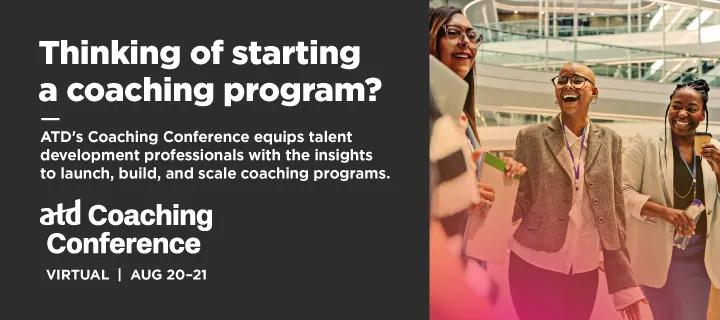ATD Blog
The Coaching Custodian’s Role in the Success of Organizational Coaching
The coaching custodian serves as the architect of organizational coaching success, creating the conditions where meaningful development can take root.
Tue Jul 01 2025

Organizational coaching stands at a crossroads. Despite substantial investment and widespread adoption, its impact remains inconsistent across different contexts. Why do some coaching engagements transform individuals and organizations while others barely leave a mark? The answer may lie not in the coach’s expertise alone, but in the systemic conditions that enable coaching to flourish.
This article examines a critical yet often overlooked role in this ecosystem—the coaching custodian. As organizations increasingly recognize that coaching success depends on client readiness rather than coach technique alone, the role of those who prepare the ground for effective coaching becomes paramount. The coaching custodian serves as the architect of organizational coaching success, creating the conditions where meaningful development can take root.
Drawing on both research and practical experience, we’ll explore how coaching custodians can systematically enhance coaching outcomes by carefully attending to five essential elements: coach screening, coaching context clarification, coaching readiness assessment, compatibility facilitation, and thorough contracting. Through this framework, organizations can transform coaching from an occasional success to a reliable catalyst for development.
The Foundations of Coaching Success: Shifting From Coach Readiness to Client Readiness
Research (DeHaan, 2019; DeHaan et al., 2020) suggests that outcomes from coaching are predicated not on the coach’s efficacy, but rather on the individual’s approach to coaching. It’s not about the tools and techniques that a coach uses, but about the relationship that the two people build together.
The most significant variable in coaching is the readiness, willingness, and ability of clients to change in ways that are meaningful to them (Drake 2023).
From experience, I notice how much of a difference it makes if the thinker with whom I’m partnering plays their part in the coaching. The part they play is in:
Thinking for themselves
Making changes because of their new thinking
This is at the heart of nondirective coaching, of which I am an advocate and practitioner, as I see the difference it makes when people learn through long-term, sustainable growth by thinking for themselves (Anagnostakis, 2023).
So, if the thinker and the relationship bear the most significance on the outcomes of coaching, it’s beholden on coaches to build that relationship and support and challenge the thinker to be coachable (Norman, 2024). They may not be intrinsically coachable, but there are ways and means by which we can cultivate it in them.
But we must broaden our view of the system of organizational coaching. Before the coach is asked in for a compatibility call, the coaching custodian (the person responsible for coaching outcomes in an organization) must play their part to ensure that the individual is indeed ready for that compatibility call and coaching-ready (Norman, 2024).
It’s too much to leave this screening to the coach. Chemistry sessions have historically tried to cover everything but the kitchen sink, and each element is therefore ill-addressed. This can lead to coaching not fulfilling its promise of impact, due to gaps in the individual’s and coach’s briefing about the context.
I’ve found, through anecdotal stories and my own experience, that coaching custodians have been tasked with this role without necessarily understanding what makes coaching successful in the organizational context. Or perhaps they are stretched so thin across multiple roles that they have become lax.
There are three elements to individual coaching readiness that the coaching custodian can focus on before inviting a coach to meet the individual:
Coach screening
Coaching context
Coaching screening (distinct from coach screening)
And two elements where the coach is involved:
Coaching compatibility
Coaching contracting
We’ll take a look at each of these elements.
Coach Screening
An organization would not employ workers or contractors without a screening process, beyond reading about their qualifications and experience in a CV. Coaching custodians must take coach screening just as seriously to ensure that the coaches in the pool are a good fit for the coaching purpose and organizational context.
All coaches, whether internal or external, should be selected using clear criteria, and the coaching custodian should not rely purely on coaching body (ICF, EMCC, AC, APECS, to provide a few examples) credentialing as this is but one aspect of the coach’s fit for purpose. The following is a good starting list of criteria to use for coach selection and can be customized depending on the organization’s needs.
Previous coaching experience: How many hours are deemed sufficient for a coach to partner with the individuals to whom the organization is providing coaching?
A coaching qualification from a reputable coach training company, where real-life coaching practice with feedback was the norm, not the exception
A coaching credential from one of the coaching bodies
Commitment to abide by a set of ethical coaching standards
Supervision by a qualified coach-supervisor
Demonstration of own personal development (beyond professional development) – willingness to learn and model the change process
Live observed coaching session, demonstrating their ability to be credible and authentic, and an understanding and appreciation of the context, culture, and mindset of the individual
Written case studies about ethical dilemmas that the coach has faced; and how coaching supervision has transformed how they work with a client
Flexibility and ability to work with a broad range of personality styles and cultures. Coaches do not need to have experience in the sector of the organization, as this is not mentoring or consultancy, but understanding how corporates generally work can be useful
Professional indemnity insurance
Data privacy adherence
Willingness to collaborate with coaching custodian and individual
Last but not least, aim for diversity in the coaching pool, not cookie-cutter coaches who are all from the same background as the coaching custodian.
Coaching Context
The coaching custodian should be ready to share with the coach and the individual the focus and purpose of the coaching. This gives them an idea of the scope of the coaching as the organization sees it (it’s their money after all), even if that coaching does move outside of that arena at times. For example, the focus might be maternity/paternity return to work, first 100 days in a new role, emerging leader, increased scope and scale, parental coaching, executive coaching, leadership coaching, retirement coaching, wellbeing, enhancement of diversity and inclusion, and high-potential advancement.
The coach and individual can also benefit from understanding whether the coaching is business-driven, individual development-needs-driven, goal-led, or program-led.
This context would be included in a briefing document for all stakeholders to ensure everyone is on the same page.
Coaching Screening
We’ve covered coach screening, but screening doesn’t stop there. Given the aforementioned research that shows that coaching’s effectiveness is not only about the coach but also about how that individual shows up in partnership with the coach, this is vital yet often overlooked.
The risks of not screening in this way might include:
Coaching may not be the best intervention for the individual or for the issues that they’re facing.
There may be missed opportunities for more applicable interventions, such as training or on-the-job stretch assignments with feedback (to name just a couple).
Coaching may be used to “outsource” problem employees to a coach, thus removing people management responsibilities from the line manager and undermining their development as a leader.
If it’s not working due to an incomplete screening process, coaching may be questioned by the organizational budget-holders. This causes stress in the system, and particularly for the coaching custodian.
The individual may come to coaching confused about what it is and isn’t. Confusion leads to stress, which in turn leads to difficulty in thinking straight (Craig 2012).
The individual won’t be prepared for the amount of hard thinking that’s involved in coaching and may become frustrated that they’re not getting what they thought they were signing up for.
The coach may become frustrated as the individual attempts to hook them into mentoring or consulting or doesn’t dedicate time or effort at all.
Therefore, the coaching custodian will want to assess, with the individual and their line manager, the following:
Is coaching the right intervention to meet the established purpose and business need?
Is the individual motivated to do the work?
Is this the right time for the individual? Is it the right time for the organization?
Is the line manager/sponsor willing to support the thinker on a day-to-day basis?
Coaching Compatibility
Only now does the coach get brought in for a compatibility call. The individual is invited to meet with the optimal fit coach, and they will decide together whether there are any reasons that the two of them should not work together. For example, does the individual believe that the coach’s style of support matches their learning and thinking styles? Will the coach’s level of challenge stretch the individual out of their comfort zone without over-stressing them? Is the individual motivated and committed to thinking and change? Are there any conflicts of interest?
If either party decides that this is not a fitting partnership, another coach will be put forward by the coaching custodian, thus offering the individual agency without overwhelming them with a choice that they are often ill-equipped to make.
Coaching Contracting
Contracting is integral to healthy relationships. There are multiple layers of contracting in organizational coaching, due to the various stakeholders:
Statement of Work between the coach and the organization
Measures of success from a three-way contracting conversation
Dyad contract including ethical practice, relational ways of working, and logistics
Dynamic re-contracting as needed
Conclusion
The coaching custodian stands as the linchpin in transforming organizational coaching from a hit-or-miss intervention to a consistently valuable development approach. By embracing the systematic framework outlined in this article—from rigorous coach screening through to comprehensive contracting—organizations can dramatically improve their return on coaching investment.
What makes this approach powerful is its recognition that coaching effectiveness emerges from a web of relationships, not just from coach expertise. The coaching custodian weaves this web carefully, ensuring all stakeholders understand their roles, and the conditions for success are established before coaching begins.
Organizations seeking to elevate their coaching impact would be well-served to formalize and strengthen the coaching custodian role. This means providing custodians with both the authority and resources to implement robust screening processes, clear contextual briefings, and thorough contracting practices. It also requires custodians themselves to develop deeper expertise in coaching dynamics and organizational systems.
If you are a coaching custodian and would like a space to reflect with others on how to increase the efficacy of your work, do get in touch at [email protected] for coaching supervision. Equally, if you are a coach (internal or external) for whom this has brought up questions and wonderings, supervision is a great place to take your dilemmas. Or start by reading my recent book, Cultivating Coachability, which will give you additional depth and breadth around coachability and coaching readiness.
As we move forward in an increasingly complex business environment, organization development approaches that combine rigour with relationship-building will prove most valuable. The coaching custodian, by bringing structure and intention to the coaching ecosystem, helps ensure that when individuals engage in the “hard work of thinking for themselves,” they do so within a system designed to support their success.
Interested in building your coaching skills? Consider ATD's Coaching Certificate.

